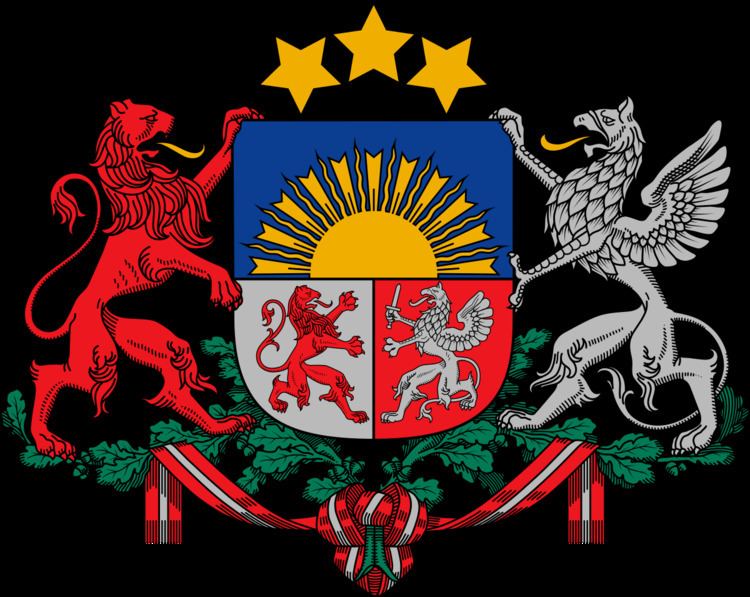Armiger Republic of Latvia | Adopted July 15, 1921 | |
 | ||
Crest An arc of three mullets Or Escutcheon Per fess and in base per pale: 1st Azure, a demi-sun issuing from base Or; 2nd Argent, a lion rampant contourné Gules; 3rd Gules, a gryphon segreant brandishing in the dexter claw a sword Argent. Compartment Two oak branches fructed Vert tied together by a ribbon Sanguine charged with a bar Argent | ||
Coat of arms of Republic of Latvia was officially adopted by the Constitutional Assembly of Latvia on July 15, 1921 and was in official use from August 19, 1921. It was created using new national symbols and older heraldic elements from Polish Livonia and Duchy of Courland and Semigallia. Thus the coat of arms combines symbols of Latvian national statehood, as well as symbols of its ancient historical districts. The Latvian national coat of arms was designed by the Latvian artist Rihards Zariņš.
Contents
Elements
The three golden stars above the Field represent three historical provinces: Vidzeme (Swedish Livonia), Latgale (Polish Livonia) and Kurzeme-Zemgale (Duchy of Courland and Semigalia).
The golden Sun in the Field represents the Sun of freedom. Sun symbol was used as a symbol of distinction and national identity by the Imperial Russian Army's Latvian Riflemen units during World War I. During the war, the Sun was fashioned with 17 rays that symbolized the 17 Latvian inhabited districts.
The bottom part of Escutcheon is divided into two fieds where the red lion of Courland represents Kurzeme and Zemgale while the silver griffin of Polish Livionia represents Vidzeme and Latgale. The red lion and silver griffin are also used as Supporters.
Base of the coat of arms is decorated with the branches of an oak tree, Quercus robur, which is one of Latvian national symbols.
Historic meaning
Historical regions were characterized by older heraldic figures, which already appeared in the 16th century. Courland and Semigalia (Western Latvia) are symbolized by a red lion, which appears as early as 1569 in the coat of arms of the former Duke of Courland and Semigalia.
Vidzeme and Latgale (Eastern Latvia) are symbolized by the legendary winged silver creature with an eagle's head, a griffin. The Gryf coat of arms as the heraldic symbol of the Duchy of Livonia appeared in 1566, when the territories known today as Vidzeme and Latgale had come under Lithuanian control and Jan Hieronimowicz Chodkiewicz was made the first governor of Duchy of Livonia (1566–78).
Usage
The proper use of the Latvian coat of arms is firmly regulated. Three types of symbol are used — the large coat of arms, the small enhanced coat of arms and the small coat of arms.
After the Soviet occupation of Latvia in 1940, coat of arms was used until August 5, 1940. During the existence of Latvian Soviet Socialist Republic the emblem of the Latvian Soviet Socialist Republic was used. The Latvian coat of arms was restored once again on February 15, 1990.
Colors
The official colors used in the coat of arms are defined according to the Pantone Color Matching System thus:
